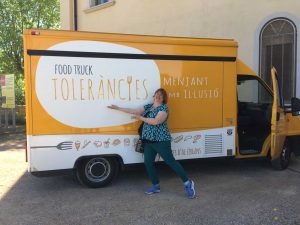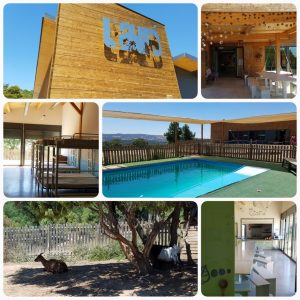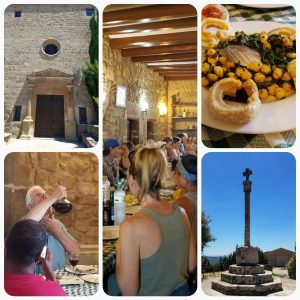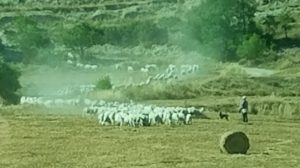Leader, food allergens, an educational farm, a masia, and ice cream!
By Michele Kroll and Zoe Larmer
Happy birthday America! Today we went on a field trip to Solsones to look at agri-tourism in Catalonya from an Urban -Rural linkages perspective. Once again, we enjoyed wonderful food in a beautiful place while also learning about the public and private organizations and businesses that support this area.
Stop 1: Leader Program and local action groups

View from our classroom window in Solsona.
Photo by Zoe Larmer
We started our day in Solsana learning about ARCA and the LEADER program from Gemma Estany Ferre. ARCA promotes rural development and rural entrepreneurship through the use of the European Union’s LEADER program. The LEADER program provides grants for local projects that promote rural development. These projects are both public and private and help both new and existing businesses. It also helps provide support to Local Action Groups (LAG). These LAGs are key to implementing LEADER grants. We also learned about the development strategy from Jordi Vilalta Mora. Both Jordi and Gemma talked about the importance of rural development coming from the “bottom up” with support from outside sources, like the LEADER program.
A one woman business: Education, food classes and food truck to rural areas

Michele Kroll with gluten free food truck.
Photo by Zoe Larmer
We enjoyed learning about this innovative approach because one of us has extreme food allergies and celiacs. We could compare the accessibility to specialized foods in the United States in the rural counties where we live. Although we do have access to specialized food most of it is pre-packaged or frozen and not fresh. There is also an educational linkage that is missing as well. Many people in the areas where we live believe celiacs or gluten intolerance is a “fad diet” and not an auto-immune disease. Often we must bring our own food or arrange special food in the work environment. This business venture really intrigues us and is something that we could see working well in the rural areas that surround us.
Stop 2: Visit to l’Auro an educational rural farm and Hostel with disability access
The location of l’Auro was beautiful and remote. After a little trouble finding our way through the narrow dirt roads (our bus driver is a champion) we enjoyed seeing all of the animals and the incredible view.

Views from farm hostel.
Photos by Michelle Kroll.
This is an example of urban dwellers moving into the rural community and building something innovative in a rural community. They were “outsiders” from the local’s point of view and not supported at all during the planning and building stages. Today they are seen by the locals as contributors to the rural economy.
Cultural Heritage: Lunch at Santuari de Pinos

Lunch at Santuari de Pinos.
Michelle Kroll photo.
We had a wonderful lunch at a Santuari de Pinos, a monastery turned restaurant. This was another great example of rural entrepreneurship. The food was delicious, the location was beautiful, and the company was entertaining (see John Bryden taking the “wine challenge”)!
Stop 3: Masia Puipelat Farm

700 Sheep Run at Masia Puipelat.
Michelle Kroll photo.
This is a family farm operation that has been inherited from generation to generation. It is a large operation with 700 sheep, 1100 pigs, crops, orchards and other products. This farm is run by a wholistic view from the point of sustainability. What they put on the land effects their family and the others around them. They take it upon themselves to manage the forest that surrounds their property and use direct sowing without ploughing to reduce soil erosion. The notion of the inheritance tax policy was interesting and I wonder if there are ways or loopholes around some of the tax depending on how it is listed or described. Is it a way for the government to gain property if a generation can’t pay off the tax?
Pasta Fresca Ambrosetti –
This rural business was established by Italian immigrants to establish themselves in the rural community and have the lifestyle that they wanted to live. They create ice cream with high quality ingredients without refined sugars. It is considered “gourmet” and they market mostly by word of mouth. They had a homemade pasta business for 20 years so they were already established in added value products. We tasted the ice cream at the Masia Puipelat. As we reflect about this business during our debriefing session we are wondering if they are still considered “outsiders” and how embracing is the region to immigrants? What were their challenges in establishing relationships with the local rural people and are they now considered part of the community? There is a lot of bartering of products in this area by farmers so we are wondering if they are included in that system?
